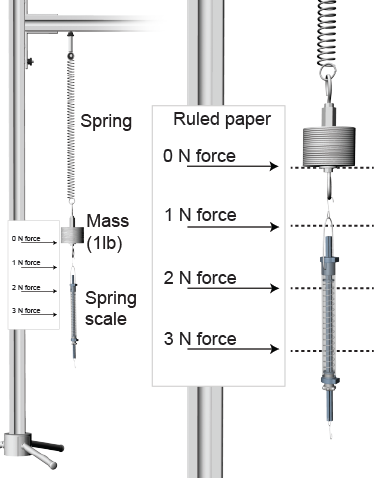| | Essential questions | | How are force and displacement related when stretching a spring? | |
|
Springs are seemingly simple devices that are found inside many different everyday items, from automatic door closers to car suspensions. Stretch a spring and it exerts a force that tends to restore the spring back to its equilibrium length. The physics underlying the spring can be expressed by a straightforward relationship, known as Hooke’s law, between how much the spring is extended (or compressed) and the restoring force the spring exerts. In this investigation, you will explore Hooke’s law and determine the difference between a stiff and a loose spring. 
|
Part 1: Extension and restoring force of a spring

- Set up the equipment as in the diagram, using the looser spring.
- With the spring scale attached as shown, mark the equilibrium position of the bottom end of the spring on the ruled paper as “0 N.”
- Pull down the spring scale by 1 N to extend the spring. Mark the new location of the end of the spring on the ruled paper with a label “1 N.”
- Pull down the spring for forces of 2, 3, 4, and 5 N, each time marking the position of the end of the spring on the paper and labeling each mark with the force.
- Remove the paper and measure the distance x (in meters) of each point from the equilibrium position. Record your data.
- Graph your data. Graph the deformation x on the horizontal axis and force F on the vertical axis. Draw a straight best-fit line through your data points.
- What is the slope of your graph? (Include units in your answer.)
- What physical quantity does the slope of your graph represent? Why?
- In steps 4 and 5 above, what were the independent, dependent, and controlled variables?
- Use your data to determine the force the spring would exert at other deformations supplied by your teacher.

|
Part 2: Stiff and loose springs
- Now substitute a “stiff” spring for the “loose” one. Then set up the experiment as before.
- Repeat the steps of stretching the spring scale to different forces. Record and graph your data.
- When you stretch the stiff spring by hand, how does it feel or respond differently from the loose spring? In supporting your answer, use data from your investigation.
- How does the extension of the stiff spring compare to that of the loose one for the same applied force?

|
| |
|

